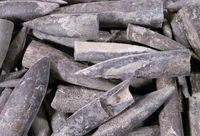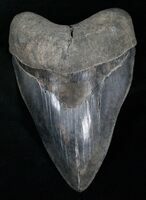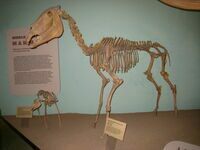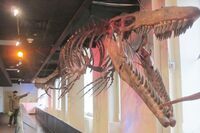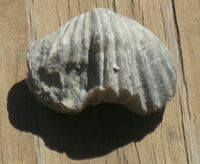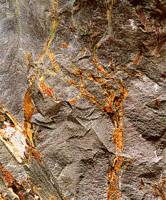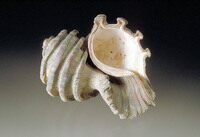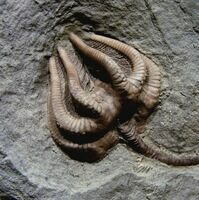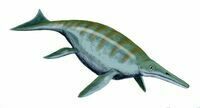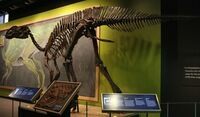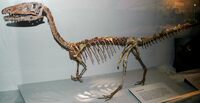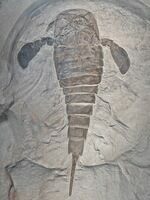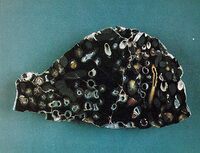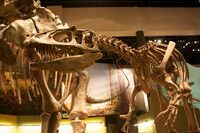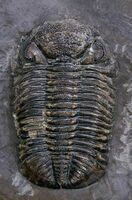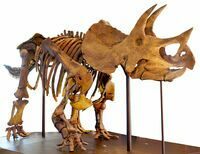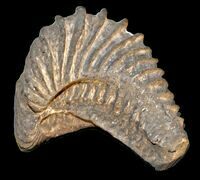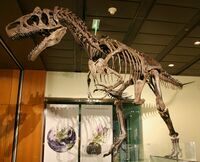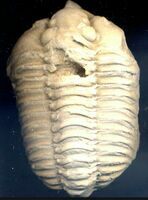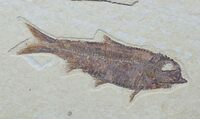List of State Fossils
The majority of the states in the United States have an official state fossil designation. Several states have fossils unofficially designated thanks to a fossil being designated as the “State Dinosaur” or “State Stone”. There are 7 states without a state fossil designation, Arkansas, Hawaii, Indiana, Iowa, Minnesota, New Hampshire and Rhode Island.
Click on a state or scroll down for the full list...
Alabama State Fossil - Alaska State Fossil - Arizona State Fossil - Arkansas State Fossil - California State Fossil - Colorado State Fossil - Connecticut State Fossil - Delaware State Fossil - Florida State Fossil - Georgia State Fossil - Hawaii State Fossil - Idaho State Fossil - Illinois State Fossil - Indiana State Fossil - Iowa State Fossil - Kansas State Fossil - Kentucky State Fossil - Louisiana State Fossil - Maine State Fossil - Maryland State Fossil - Massachusetts State Fossil - Michigan State Fossil - Minnesota State Fossil - Mississippi State Fossil - Missouri State Fossil - Montana State Fossil - Nebraska State Fossil - Nevada State Fossil - New Hampshire State Fossil - New Jersey State Fossil - New Mexico State Fossil - New York State Fossil - North Carolina State Fossil - Ohio State Fossil - Oklahoma State Fossil - Oregon State Fossil - Pennsylvania State Fossil - Rhode Island State Fossil - South Carolina State Fossil - South Dakota State Fossil - Tennessee State Fossil - Texas State Fossil - Utah State Fossil - Vermont State Fossil - Virginia State Fossil - Washington State Fossil - West Virginia State Fossil - Wyoming State Fossil - Wisconsin State Fossil
Fossil: Primitive Whale (Basilosaurus cetoides)
Age: Eocene
Year Designated: 1984
Basilosaurus ("king lizard") is a genus of early whale that lived 40 to 34 million years ago in the late Eocene. Basilosaurus represents one of the earliest whales although it is actually descended from land mammals. The front flippers had an elbow joint and the back flippers where hind legs would have been are greatly reduced in size. It's estimated it could reach gigantic sizes of 40-60 feet in length. These ancient whale fossils are most abundant in Alabama but fossil remains of the Basilosaurus cetoides may not be removed from the state without prior written approval of the governor.
Fossil: Woolly Mammoth (Mammuthus primigenius)
Age: Pleistocene
Year Designated: 1986
The Woolly Mammoth or Mammuthus primigenius was a species of mammoth. The common name for the extinct elephant genus Mammuthus. It was about the size of a modern day elephant, covered in fur and lived from 400,000 years ago to as recent as 4,000 years ago. It first evolved in Eurasia and entered Alaska from Siberia over the Bering Land Bridge around 65,000 years ago. It's fossils are frequently found in Alaska by gold miners after being washed out of stream banks.
Fossil: Petrified Wood (Araucarioxylon arizonicum)
Age: Triassic
Year Designated: 1988
Arizona is famous for it's vast petrified forest, so it makes sense that Arizona's state fossil would be the most plentiful species of fossil tree in that forest, Araucarioxylon arizonicum. Petrified wood is fossil wood that has been turn to a fossil via permineralization. That is the organic wood material was replaced with minerals by water after it was buried. The Petrified Forest National Monument is located north of I-40 east of Holbrook and is from the Triassic age, approximately 200 million years ago.
Fossil: Arkansaurus fridayi
Age: Early Cretaceous
Year Designated: 2017
Arkansaurus, a bipedal coelurosaurian dinosaur, is the only dinosaur whose remains have been found in Arkansas. Joe B. Friday discovered the dinosaur's fossilized foot in a gravel pit near Lockesburg in 1972 when he was out looking for a cow.
Fossil: Saber-Toothed Cat (Smilodon californicus)
Age: Pleistocene
Year Designated: 1974
Fossils of the Saber-Toothed Cat (Smilodon californicus) are abundant at the La Brea Tar Pits in Los Angeles. Smilodon is one of the most recognizable of the ferocious saber-toothed cats which roamed the Americas up until 11,000 years ago. They could weight up to 350 kg and had massive, 8 inch long upper canine teeth which they used to prey on large ice age mammals.
Fossil: Dinosaur (Stegosaurus stenops)
Age: Jurassic
Year Designated: 1972
The spike-tailed Stegosaurus is one of the most iconic and recognizable dinosaurs. It's rare fossils can be found in the Jurassic aged Morrison Formation of Colorado. It is believed that a typical Stegosaurus weighed five to ten tons but had a brain that was only about 2 ounces (the size of a walnut). But no, it did not have two brains. While probably not the brightest of the dinosaurs it had a formidable array of armored plates, and a spiked tail with which to defend itself.
Fossil: Dinosaur Tracks (Eubrontes giganteus)
Age: Jurassic
Year Designated: 1991
The Connecticut Valley is home to one of the most impressive dinosaur track sites in the world. Tracks of many different types of dinosaurs have been found preserved in the Valley's sandstone dating back to the Early Jurassic. Eubrontes is the name given to the three-toed tracks but no skeletal remains have been found of their creator and the specific genus of dinosaur is not yet known. These tracks were the first known dinosaur fossils to be discovered in North America.
Fossil: Cephalopod (Belemnitella americana)
Age: Cretaceous
Year Designated: 1996
Belemnites are an extinct group of squid-like cephalopods that lived during the Jurassic and Cretaceous. They had a hard, internal, cone shaped structure that is often preserved as a fossil though it is not technically a shell. They had 10 arms but unlike modern squid these arms had small hooks instead of suckers.
Belemnites of the species Belemnitella americana are found abundantly in the exposures of the Mount Laurel Formation along the banks of the Chesapeake and Delaware Canal. The fine-grained sands and silts of the Mount Laurel were deposited in a shallow sea during the Late Cretaceous.
Fossil: Agatized Coral (Anthozoa)
Age: Eocene
Year Designated: 1979 (Designated State Stone)
Currently, Florida does not officially recognize a state fossil but it's state stone is actually a fossil, so we'll count it. The state stone, err fossil is agatized coral and the most commonly found type found in Florida is Anthozoa. "Agatized" is a common name given to fossils that have been replaced by silica and contaminate minerals which provide the color. Agate replaced, fossil coral is found in several Florida locations and may have been formed when runoffs of silt rich is clay and silica buried an Eocene aged Coral reef. Some of the first inhabitants of Florida some 5,000 years ago used this agatized coral as a material for making stone tools and points.
Fossil: Generic Fossil Shark Tooth
Age: Cretaceous through Miocene
Year Designated: 1976
Georgia's state fossil is the fossil shark tooth without any specific species or genus identified. Fossil shark teeth are common in deposits ranging the Cretaceous through the Miocene in Georgia. The reason shark teeth are so common is that sharks shed their teeth frequently during their lifetime and an adult shark may have left behind many thousands of teeth on the seafloor. The most impressive of these fossil shark teeth found in Georgia are those of the Megalodon Shark which can reach lengths in excess of 7 inches long.
Fossil: No state fossil...
Fossil: Hagerman Horse (Equus simplicidens)
Age: Pliocene
Year Designated: 1988
The Hagerman Horse was discovered in 1928 by a cattle rancher near Hagerman, Idaho, hence the name. It is one of the oldest horses of the Equus genus appearing 3.5 million years ago and is believed to be very similar to the African Zebra. Nearly 200 fossil horse skeletons have been recovered from the Hagerman Fossil Beds National Monument.
Fossil: Tully Monster (Tullimonstrum gregarium)
Age: Pennsylvanian
Year Designated: 1989
The "Tully Monser" (Tullimonstrum gregarium) was a soft-bodied invertebrate of unknown affinities that lived in the the waters of muddy estuaries during the Pennsylvanian period, 300 million years ago. Its fossils have only been found in the Mazon Creek fossil beds of Illinois, United States. It lacks characteristics of any modern phyla and paleontologists speculate that it may be a representative of a stem group to one of the many phyla of worms.
Fossil: None, but crinoid (Elegantocrinus hemisphaericus) proposed
Fossil: No state fossil, lame...
Fossil: Pteranodon (flying reptile) & Tylosaurus (marine reptile)
Age: Cretaceous
Year Designated: 2014
Kansas, the most recent state to designate a state fossil, decided to make up for being late to the party and designate two. They designated to two reptiles that inhabited the Western Interior Seaway that covered Kansas during the late Cretaceous period. Tylosaurus, a type of Mosasaur was a giant, predatory marine lizard that could reach sizes of up to 50 feet in length. Pteranodon is a type of pterosaurs which included some of the largest known flying reptiles, with wingspans up to 20 ft.
Fossil: Brachiopod
Age: Paleozoic
Year Designated: 1986
Brachiopod shells are probably the most commonly found fossils in Kentucky. They are so many different species of fossil brachiopods found in Kentucky, the state simply designated the entire group as the state fossil. Brachiopods are marine animals that superficially resembled clams, but are a completely different phylum with a vastly different internal structure.
Fossil: Petrified Palmwood (Palmoxylon sp.)
Age: Oligocene
Year Designated: 1976
Petrified palm wood is the Louisiana state fossil and is characterized by prominent rod-like structures within the regular grain of the petrified wood. In Louisiana, petrified palm wood belongs to the genus Palmoxylon. It is found within the Catahoula Formation, which consists almost entirely of sediments deposited within broad, low-lying coastal plains during the Oligocene period about 30 million years ago.
Fossil: Fossil Plant (Pertica quadrifaria)
Age: Devonian
Year Designated: 1985
Pertica is a genus of extinct vascular plants of the Early to Middle Devonian (around 420 to 380 million years ago). Pertica quadrifaria (the type species of the genus) was described in 1972 from compression fossils found in the Trout Valley Formation of northern Maine, USA. It was an upright plant which grew to perhaps as much as a 3 feet in height.
Fossil: Gastropod (Ecphora gardnerae)
Age: Miocene
Year Designated: 1994
Ecphora gardnerae is a species of large carnivorous sea snail lived during the Miocene epoch, and became extinct more than five million years ago. The shells are found as fossils in Maryland and Virginia. Ecphora was one of the first fossils from the New World to be illustrated in a scientific work in Europe.
Fossil: Undetermined Dinosaur Tracks
Age: Triassic
Year Designated: 1980
The Connecticut River Valley of Western Massachusetts is one of the world's richest sources of prehistoric dinosaur tracks. The dinosaur tracks in the Connecticut Valley date from about 180 million to 210 million years ago. They are actually the first recorded dinosaur tracks being first discovered by a farmer's son in the early 1800's. The prints were first thought to be the marks of ancient birds. No one can be certain which dinosaurs made the prints, but it's believed the largest (more than a foot in length) may have been made by Dilophosaurus, a 20-foot long meat-eating dinosaur.
Fossil: Mastodon (Mammut americanum), Petoskey Stone (rugose coral, Hexagonaria percarinata)
Age: Pliocene - Pleistocene & Devonian
Year Designated: 2002 & 1965
Mammut americanum or the American mastodon is the youngest and most widely known member of the genus Mammut. Mastodons where relatives of elephants and mammoths and lived in Michigan during the Pliocene and Pleistocene.
In addition the "Petoskey Stone" which is a rock containing fossilized rugose coral (Hexagonaria percarinata) was designated the Michigan state stone in 1965. Petoskey stones are found in the Gravel Point Formation of the Traverse Group. They are fragments of a coral reef that was originally deposited during the Devonian period. The fragments were then natural polished by glaciers and are found over a wide area.
The name comes from an Ottawa Indian Chief, Chief Pet-O-Sega. The city of Petoskey, Michigan, is also named after him, and is the center of the area where the stones are found.
Fossil: No state fossil, lame...
Fossil: Primitive Whales (Basilosaurus cetoides and Zygorhiza kochii)
Age: Eocene
Year Designated: 1981
Like Alabama, Mississippi has designated a primitive whale (or rather two of them) as their state fossils. Basilosaurus and Zygorhiza are both extinct genus' of basilosaurids whales from the Late Eocene (40-34 million years ago)
Fossil: Crinoid (Delocrinus missouriensis)
Age: Pennsylvanian
Year Designated: 1989
Crinoids, sometimes commonly referred to as sea lilies are animals not plants. They are echinoderms related to starfish, sea urchins and brittle stars.
Fossil: Duck-Billed Dinosaur (Maiasaura peeblesorum)
Age: Cretaceous
Year Designated: 1985
Maiasaura is a large type of duck-billed dinosaur in Montana during the Upper Cretaceous Period, about 76.7 million years ago. Maiasaura was large, attaining an adult length of about 30 ft and had the typical hadrosaurid flat (duck-billed) beak.. It had a small, spiky crest in front of its eyes, which may have been used in headbutting contests between males during the breeding season.
Fossil: Woolly Mammoth (Mammuthus primigenius)
Age: Pleistocene
Year Designated: 1967
The mammoth was adopted as the Nebraska state fossil in 1967. The world’s largest Mammoth skeleton, nicknamed ‘Archie’ was discovered in Lincoln County, Nebraska and is currently on display at the University of Nebraska State Museum. Archie is 15 feet tall, 25 feet long and is estimate to have weighed a staggering 7 tons.
The mammoth was an elephant but much larger than the modern day version, hence the name. The remains on three different species of Mammoth that roamed the plains during the Pleistocene period have been found in Nebraska.
Fossil: None, but Mastodon proposed
Fossil: Ichthyosaur (Shonisaurus sp.)
Age: Triassic
Year Designated: 1977, amended 1989
Shonisaurus is a gigantic genus of Ichthyosaur that could reach lengths of nearly 50 feet. An Ichthyosaur is an extinct marine reptile resembling a dolphin, with a long pointed head, four flippers, and a vertical tail.
In 1928 a large bone-bed of Shonisaurus fossils was discovered near Berlin, Nevada in the Triassic aged Luning Formation. Excavations thirty years later would reveal the remains of 37 large individuals. These were named Shonisaurus, which means "Lizard from the Shoshone Mountains", after the where the fossils were found. This area is now encompassed by Berlin–Ichthyosaur State Park. Ichthyosaur fossils in general were designated as the Nevada state fossil in 1977 and this amended in 1989 to specifically be fossils of Shonisaurus.
Fossil: Duck-Billed Dinosaur (Hadrosaurus foulkii)
Age: Cretaceous
Year Designated: 1991 (State Dinosaur)
Hadrosaurus foulkii was a type of duckbilled dinosaur that roamed the forests and swamps along New Jersey's coastline 80 million years ago. It was probably about 25 feet long and 10 feet tall. Hadrosaurs are believed to have stood on their hind legs while grazing, and had a mouthful of hundreds of tiny, blocky teeth that would have functioned to grind leaves and other vegetation.
Hadrosaurus foulkii was the dinosaur known from more than isolated teeth to be found in North America. A of Hadrosaurus foulkii skeleton was discovered in 1858 by William Foulke in a marl pit near Haddonfield, New Jersey. In 1868, it became the first mounted dinosaur skeleton in the world and it was named the state dinosaur of New Jersey in 1991.
Fossil: Dinosaur (Coelophysis bauri)
Age: Triassic
Year Designated: 1981
Coelophysis bauri is an extinct species of coelophysid dinosaur that lived during the Late Triassic period, approximately 200 million years ago. It was a small, theropod dinosaur, about 6 feet in length and only weighing around 50 lbs. It was most likely a carnivore, preying on small reptiles, amphibians and early Triassic mammals.
The remains of hundreds of skeletons of Coelophysis were discovered at Ghost Ranch during the 1940s. Because of the large number of remains that have been found it is probably the best known dinosaur of the Triassic. Coelophysis was adopted as the official fossil of New Mexico by law in 1981.
Fossil: Sea Scorpion (Eurypterus remipes)
Age: Silurian
Year Designated: 1984
Eurypterus is an extinct genus of “Sea Scorpion” that lived during the Silurian Period from around around 432 to 418 million years ago. The first discovered species of the genus was Eurypterus remipes. Eurypterus averaged at about 5 to 9 inches in length and possessed spine-bearing appendages with a large paddle they used for swimming.
Eurypterus remipes lived along the bottom of the shallow, brackish sea that covered much of New York over 400 million years ago. The first fossil of Eurypterus was found in 1818 by S. L. Mitchill. It was first thought to be a fossil catfish and wasn’t correctly identified as an arthropod until years later. It was named the official state fossil of NY in 1984.
Fossil: Megalodon Teeth (Carcharodon megalodon)
Age: Miocene
Year Designated: 2013
The official state fossil of North Carolina is fossilized teeth of the extinct, mega-mouthed shark Carcharocles megalodon. Megalodon is the largest known predator in the history of the planet having been estimated to reach sizes of up to 60 feet long. Huge serrated teeth up to 7 1/2 inches have been discovered. It's a good thing that this gigantic shark went extinct about 2.6 million years ago.
Fossil teeth of the Megalodon are relatively common fossils in North Carolina. They are popularly collected by divers in the rivers and offshore after they erode out of the Miocene aged Hawthorn Formation. These fossil teeth were adopted as the official state fossil of North Carolina in 2013.
Fossil: Teredo Petrified Wood
Age: Paleocene
Year Designated: 1967
Teredo wood the name that is given to wood that was bored into by small marine mollusks called shipworms. Thus, petrified teredo wood would be the fossils of this wood bearing the distinctive boreholes.
During the Paleocene (around 60 million years ago) parts of North Dakota were covered by warm water swamps, similar to Florida today. Sequoias and other trees growing in these swamps fell into the water and were washed out to sea become driftwood. They would then be bored into by the marine shipworms. Under the right conditions this driftwood would become fossilized and replaced with silica through the process of petrification.
Teredo petrified wood is a common fossil in the Cannonball formation of South-Central North Dakota. It was designated the North Dakota state fossil in 1967.
Fossil: Trilobite (Isotelus)
Age: Ordovician
Year Designated: 1985
Isotelus is a genus to large Asaphid trilobite that lived during the Ordovician Period. It’s fossils are common within several formations that outcrop in Southwestern Ohio. The largest Isotelus trilobite to be found in Ohio is about 16 inches long though the largest known trilobite Isotelus rex found in Manitoba, Canada is from the same genus.
The most famous specimen of Isotelus from Ohio was discovered in 1919 while digging an outlet tunnel during the construction of the Huffman Dam near Dayton. This giant trilobite specimen measures 14 ½ inches long. A couple elementary school classes in Dayton proposed naming this specimen of the official state fossil. While declining to designate only that specific specimen, the legislature instead passed a bill naming the genus Isotelus in 1985.
Fossil: Theropod Dinosaur (Saurophaganax maximus)
Age: Jurassic
Year Designated: 2000
Saurophaganax is a genus of allosaurid dinosaur from the Late Jurassic (~151 million years old) Morrison Formation of Oklahoma. It was a truly massive predator, estimated to have reached a maximum size of 34-43 feet in length. The first bones of Saurophaganax were found in the early 1930s near Kenton, Oklahoma. Since that time, discoveries have been rare and fragmentary.
On April, 14th, 2000 the governor of Oklahoma signed a senate bill designating Saurophaganax maximus as the official Oklahoma state fossil
Fossil: Plant - Dawn Redwood (Metasequoia)
Age: Miocene
Year Designated: 2005
The Metasequoia or “Dawn redwood” is a deciduous conifer that flourished from 34 to 5 million years ago. It’s fossils are common in rocks of these ages in Oregon and many other areas of the Pacific Northwest. It was made the official Oregon state fossil in 2005 after intense lobbying by a local fossil enthusiast who presented every legislator with a Metasequoia fossil. It’s an appropriate fossil for the state, because of the states prominent timber heritage.
Fossil: Trilobite (Phacops rana rana)
Age: Devonian
Year Designated: 1988
Phacops may be the most widely recognizable type of trilobite fossil in the world. Phacops rana is a species of the genus that can found in Pennsylvania's Devonian aged rocks. Trilobites are an extinct marine arthropod that occurred abundantly during the Paleozoic era.
Phacops rana was named the official state fossil of Pennsylvania in 1988 after being proposed to lawmakers by a elementary school science class.
Fossil: Columbian Mammoth (Mammuthus columbi)
Age: Pleistocene
Year Designated: 2014
The Columbian mammoth became the official state fossil of South Carolina in 2014. South Carolina is the sixth state to make a mammoth the state fossil, and the second most recent to official name a state fossil. It almost didn’t happen because of months of delays by creationist lawmakers who tried to add amendments referring to the book of Genesis and God's creation to the law.
“The Columbian Mammoth, which was created on the Sixth Day with the other beasts of the field, is designated as the official State Fossil of South Carolina and must be officially referred to as the 'Columbian Mammoth,' which was created on the Sixth Day with the other beasts of the field."
It took much pleading by state residents to keep religion out of science but eventually the bill passed free of religious amendments.
Fossil: Dinosaur (Triceratops horridus)
Age: Cretaceous
Year Designated: 1988
Prior to 1988 the official state fossil of South Dakota was the cycad, a type of palm like Mesozoic plant. Legislators decided to change it to one of the most recognizable dinosaurs to all-time, Triceratops.
The horned dinosaur Triceratops is one of the most common dinosaur fossils in the Cretaceous aged Hell Creek Formation that outcrops in South Dakota. Many fine specimens of this large, rhinocerous looking herbivore have been discovered in South Dakota. Read more about Triceratops.
Fossil: No state fossil, lame...
Fossil: Bivalve Mollusc (Pterotrigonia thoracica)
Age: Cretaceous
Year Designated: 1998
Pterorigonia is an extinct genus of that is a common fossil in the Cretaceous aged rocks in West Tennessee. About 70 million years ago, much of Tennessee was covered by a shallow sea. In 1998 Pterorigonia thoracica was named as the official state fossil of the state.
Fossil: Sauropod Dinosaur (Paluxysaurus jonesi) & Petrified Palm Wood (Palmoxylon sp)
Age: Cretaceous & Oligocene
Year Designated: 2009 (State Dinosaur) & 1969 (State Stone)
The Early Cretaceous sauropod dinosaur Paluxysaurus jonesi is estimated to have been about 60 feet long, 26 feet of that being it’s long neck. It is a relative of Brachiosaurus & Camarasaurus and its tracks can be viewed at Dinosaur Valley State Park near Glen Rose, Texas. Complete skeletons of this dinosaur are unknown, and most material is fragmentary.
Originally the official state dinosaur was Pleurocoelus but that designation only lasted seven years when the bones were determined to have come from a different genus and species, Paluxysaurus jonesi. In 2009 Governor Rick Perry signed House Concurrent Resolution No changing the name of the state dinosaur to match.
Texas's state stone, petrified Palmoxylon wood also happens to be a fossil.
Fossil: Theropod Dinosaur (Allosaurus
fragilis)
Age: Jurassic
Year Designated: 1988
Allosaurus is a well-known predatory dinosaur that lived during the Jurassic period and probably hunted in packs. It averaged about 25-30 feet in length and is the most common dinosaur fossil found in the Morrison Formation that outcrops in Eastern Utah. Over 60 skeletons, representing both adults and juveniles of the species have been found in one quarry in Utah along. It’s skull could reach up to 3 feet in length with backwardly curving teeth. It could open its jaw very wide and it has been theorized that it used it’s upper jaw like a hatchet to attach prey.
The Allosaurus was designated the Utah State Fossil in 1988.
Fossil: Whale (Delphinapterus leucas) & Mount Holly mammoth tooth and tusk
Age: Pleistocene
Year Designated: 1993 (State terrestrial fossil) & 2014 (State marine fossil)
Vermont has two state fossils designated, a state terrestrial (land) fossil and a state marine fossil.
The “Mount Holly mammoth” was designated as the state terrestrial fossil in 2014. Discovered in 1848, the Mount Holly Mammoth consists of a partial mammoth found in a peat bog on Mt. Holly while making an excavation for a railroad.
"In making this excavation, the workmen found at the bottom of the bed, resting upon gravel which separated it from the rock below, a huge tooth. The depth of the peat at that place was eleven feet. Soon afterwards one of the tusks was found, about eighty feet from the place of the tooth mentioned above, which was a grinder. Subsequently the other tusk and several of the bones of the animal were found near the same place. These bones and teeth were submitted to the inspection of Professor Agassiz, who pronounced them to be extinct species of elephant. The directors of the R.& B.R.R. to whom they belong, placed them in the museum of the University of Vermont, for preservation, and for the illustration of our fossil geology.”
In 1993 a fossil beluga whale skeleton was designated as the official Vermont Marine Fossil. Vermont is the only state that designates a fossil symbol from a species that still exists today.
Fossil: Bivalve Scallop (Chesapecten jeffersonius)
Age: Pliocene
Year Designated: 1993
The prehistoric scallop Chesapecten jeffersonius holds the distinction of being the first fossil illustrated in a scientific publication from North America in 1687. It would later be named in honor Thomas Jefferson because of his interest in natural history and to celebrate the Chesapeake Bay, the largest estuary in the US. Fossils of this 4 million year old shellfish are commonly found in streams and beaches of Southeastern Virginia. It is an index fossil for the Lower Yorktown Formation.
In 1993 is was officially adopted at the Virginia state fossil.
Fossil: Columbian Mammoth (Mammuthus columbi) & Petrified Wood
Age: Pleistocene & Miocene
Year Designated: 1998 & 1975
Washington is one of six states to have a mammoth, designated as their state fossil, but Washington was one of the first to do so. So, it’s the other states being unoriginal. Petrified wood (a fossil) is also designated as the state stone. Fossilized remains of the Columbian mammoth were found on the Olympic Peninsula in Western Washington and petrified wood at several localities in Eastern Washington.
Fossil: Giant Ground Sloth (Megalonyx jeffersonnii)
Age: Pleistocene
Year Designated: 2008
Megalonyx jeffersonii is an extinct giant ground sloth that lived in North America from the Late Miocene (10 million years ago) through the Pleistocene (11k years ago) It was nearly 10 feet high and weight up to a ton. It is one of the most unusual North American ice-age mammals. It had thick hair that enabled the species to endure colder temperatures and range farther north than other ground sloths. It’s name latin for “Great Claw” from the fact that it had a giant claw.
Like the state fossil of Virginia the species is named after fossil lover and third president of the United State, Thomas Jefferson. His lecture on Megalonyx to the American Philosophical Society in 1797 marked the beginning of vertebrate paleontology in North America. In 2008 Megalonyx jeffersonii was officially adopted as the West Virginia state fossil.
Fossil: Trilobite (Calymene celebra)
Age: Silurian
Year Designated: 1985
In 1985 the trilobite Calymene celebra was adopted as the official Wisconsin state fossil. Trilobites are extinct marine arthropods which dominated the seas during the Paleozoic period. Calymene celebra lived during the Silurian period, at a time when warm, shallow seas covered the state. Its fossils are common in the vast Niagara dolomite outcroppings which are exposed in the state.
Fossil: Fossil FIsh (Knightia) & Dinosaur (Triceratops)
Age: Eocene & Cretaceous
Year Designated: 1987 & 1994
Wyoming has both a state fossil, designated in 1987 and a state dinosaur designated in 1994.
Knightia a genus of fossil herring was designated at the official state fossil. 45-50 million years ago, several large, freshwater lakes covered the Southwestern part of Wyoming, as well as areas of Utah and Colorado. Periodically there were mass die-offs of fish in the lake, potentially caused by volcanic eruptions, temperature fluctuations, or algal blooms. A low oxygen environment at the bottom of the lake allowed for beautiful preservation of these fish as fossils. Today these fossils are found in huge numbers at several quarries near Kemmerer, WY. Knightia is the most common of the fossil fish from the Green River Formation.
Click on a state or scroll down for the full list...
Alabama State Fossil - Alaska State Fossil - Arizona State Fossil - Arkansas State Fossil - California State Fossil - Colorado State Fossil - Connecticut State Fossil - Delaware State Fossil - Florida State Fossil - Georgia State Fossil - Hawaii State Fossil - Idaho State Fossil - Illinois State Fossil - Indiana State Fossil - Iowa State Fossil - Kansas State Fossil - Kentucky State Fossil - Louisiana State Fossil - Maine State Fossil - Maryland State Fossil - Massachusetts State Fossil - Michigan State Fossil - Minnesota State Fossil - Mississippi State Fossil - Missouri State Fossil - Montana State Fossil - Nebraska State Fossil - Nevada State Fossil - New Hampshire State Fossil - New Jersey State Fossil - New Mexico State Fossil - New York State Fossil - North Carolina State Fossil - Ohio State Fossil - Oklahoma State Fossil - Oregon State Fossil - Pennsylvania State Fossil - Rhode Island State Fossil - South Carolina State Fossil - South Dakota State Fossil - Tennessee State Fossil - Texas State Fossil - Utah State Fossil - Vermont State Fossil - Virginia State Fossil - Washington State Fossil - West Virginia State Fossil - Wyoming State Fossil - Wisconsin State Fossil
Alabama State Fossil
Fossil: Primitive Whale (Basilosaurus cetoides)
Age: Eocene
Year Designated: 1984
Basilosaurus ("king lizard") is a genus of early whale that lived 40 to 34 million years ago in the late Eocene. Basilosaurus represents one of the earliest whales although it is actually descended from land mammals. The front flippers had an elbow joint and the back flippers where hind legs would have been are greatly reduced in size. It's estimated it could reach gigantic sizes of 40-60 feet in length. These ancient whale fossils are most abundant in Alabama but fossil remains of the Basilosaurus cetoides may not be removed from the state without prior written approval of the governor.
Alaska State Fossil
Fossil: Woolly Mammoth (Mammuthus primigenius)
Age: Pleistocene
Year Designated: 1986
The Woolly Mammoth or Mammuthus primigenius was a species of mammoth. The common name for the extinct elephant genus Mammuthus. It was about the size of a modern day elephant, covered in fur and lived from 400,000 years ago to as recent as 4,000 years ago. It first evolved in Eurasia and entered Alaska from Siberia over the Bering Land Bridge around 65,000 years ago. It's fossils are frequently found in Alaska by gold miners after being washed out of stream banks.
Arizona State Fossil
Fossil: Petrified Wood (Araucarioxylon arizonicum)
Age: Triassic
Year Designated: 1988
Arizona is famous for it's vast petrified forest, so it makes sense that Arizona's state fossil would be the most plentiful species of fossil tree in that forest, Araucarioxylon arizonicum. Petrified wood is fossil wood that has been turn to a fossil via permineralization. That is the organic wood material was replaced with minerals by water after it was buried. The Petrified Forest National Monument is located north of I-40 east of Holbrook and is from the Triassic age, approximately 200 million years ago.
Arkansas State Fossil
Fossil: Arkansaurus fridayi
Age: Early Cretaceous
Year Designated: 2017
Arkansaurus, a bipedal coelurosaurian dinosaur, is the only dinosaur whose remains have been found in Arkansas. Joe B. Friday discovered the dinosaur's fossilized foot in a gravel pit near Lockesburg in 1972 when he was out looking for a cow.
California State Fossil
Fossil: Saber-Toothed Cat (Smilodon californicus)
Age: Pleistocene
Year Designated: 1974
Fossils of the Saber-Toothed Cat (Smilodon californicus) are abundant at the La Brea Tar Pits in Los Angeles. Smilodon is one of the most recognizable of the ferocious saber-toothed cats which roamed the Americas up until 11,000 years ago. They could weight up to 350 kg and had massive, 8 inch long upper canine teeth which they used to prey on large ice age mammals.
Colorado State Fossil
Fossil: Dinosaur (Stegosaurus stenops)
Age: Jurassic
Year Designated: 1972
The spike-tailed Stegosaurus is one of the most iconic and recognizable dinosaurs. It's rare fossils can be found in the Jurassic aged Morrison Formation of Colorado. It is believed that a typical Stegosaurus weighed five to ten tons but had a brain that was only about 2 ounces (the size of a walnut). But no, it did not have two brains. While probably not the brightest of the dinosaurs it had a formidable array of armored plates, and a spiked tail with which to defend itself.
Connecticut State Fossil
Fossil: Dinosaur Tracks (Eubrontes giganteus)
Age: Jurassic
Year Designated: 1991
The Connecticut Valley is home to one of the most impressive dinosaur track sites in the world. Tracks of many different types of dinosaurs have been found preserved in the Valley's sandstone dating back to the Early Jurassic. Eubrontes is the name given to the three-toed tracks but no skeletal remains have been found of their creator and the specific genus of dinosaur is not yet known. These tracks were the first known dinosaur fossils to be discovered in North America.
Delaware State Fossil
Fossil: Cephalopod (Belemnitella americana)
Age: Cretaceous
Year Designated: 1996
Belemnites are an extinct group of squid-like cephalopods that lived during the Jurassic and Cretaceous. They had a hard, internal, cone shaped structure that is often preserved as a fossil though it is not technically a shell. They had 10 arms but unlike modern squid these arms had small hooks instead of suckers.
Belemnites of the species Belemnitella americana are found abundantly in the exposures of the Mount Laurel Formation along the banks of the Chesapeake and Delaware Canal. The fine-grained sands and silts of the Mount Laurel were deposited in a shallow sea during the Late Cretaceous.
Florida State Fossil
Fossil: Agatized Coral (Anthozoa)
Age: Eocene
Year Designated: 1979 (Designated State Stone)
Currently, Florida does not officially recognize a state fossil but it's state stone is actually a fossil, so we'll count it. The state stone, err fossil is agatized coral and the most commonly found type found in Florida is Anthozoa. "Agatized" is a common name given to fossils that have been replaced by silica and contaminate minerals which provide the color. Agate replaced, fossil coral is found in several Florida locations and may have been formed when runoffs of silt rich is clay and silica buried an Eocene aged Coral reef. Some of the first inhabitants of Florida some 5,000 years ago used this agatized coral as a material for making stone tools and points.
Georgia State Fossil
Fossil: Generic Fossil Shark Tooth
Age: Cretaceous through Miocene
Year Designated: 1976
Georgia's state fossil is the fossil shark tooth without any specific species or genus identified. Fossil shark teeth are common in deposits ranging the Cretaceous through the Miocene in Georgia. The reason shark teeth are so common is that sharks shed their teeth frequently during their lifetime and an adult shark may have left behind many thousands of teeth on the seafloor. The most impressive of these fossil shark teeth found in Georgia are those of the Megalodon Shark which can reach lengths in excess of 7 inches long.
Hawaii State Fossil
Fossil: No state fossil...
Idaho State Fossil
Fossil: Hagerman Horse (Equus simplicidens)
Age: Pliocene
Year Designated: 1988
The Hagerman Horse was discovered in 1928 by a cattle rancher near Hagerman, Idaho, hence the name. It is one of the oldest horses of the Equus genus appearing 3.5 million years ago and is believed to be very similar to the African Zebra. Nearly 200 fossil horse skeletons have been recovered from the Hagerman Fossil Beds National Monument.
Illinois State Fossil
Fossil: Tully Monster (Tullimonstrum gregarium)
Age: Pennsylvanian
Year Designated: 1989
The "Tully Monser" (Tullimonstrum gregarium) was a soft-bodied invertebrate of unknown affinities that lived in the the waters of muddy estuaries during the Pennsylvanian period, 300 million years ago. Its fossils have only been found in the Mazon Creek fossil beds of Illinois, United States. It lacks characteristics of any modern phyla and paleontologists speculate that it may be a representative of a stem group to one of the many phyla of worms.
Indiana State Fossil
Fossil: None, but crinoid (Elegantocrinus hemisphaericus) proposed
Iowa State Fossil
Fossil: No state fossil, lame...
Kansas State Fossil
Fossil: Pteranodon (flying reptile) & Tylosaurus (marine reptile)
Age: Cretaceous
Year Designated: 2014
Kansas, the most recent state to designate a state fossil, decided to make up for being late to the party and designate two. They designated to two reptiles that inhabited the Western Interior Seaway that covered Kansas during the late Cretaceous period. Tylosaurus, a type of Mosasaur was a giant, predatory marine lizard that could reach sizes of up to 50 feet in length. Pteranodon is a type of pterosaurs which included some of the largest known flying reptiles, with wingspans up to 20 ft.
Kentucky State Fossil
Fossil: Brachiopod
Age: Paleozoic
Year Designated: 1986
Brachiopod shells are probably the most commonly found fossils in Kentucky. They are so many different species of fossil brachiopods found in Kentucky, the state simply designated the entire group as the state fossil. Brachiopods are marine animals that superficially resembled clams, but are a completely different phylum with a vastly different internal structure.
Louisiana State Fossil
Fossil: Petrified Palmwood (Palmoxylon sp.)
Age: Oligocene
Year Designated: 1976
Petrified palm wood is the Louisiana state fossil and is characterized by prominent rod-like structures within the regular grain of the petrified wood. In Louisiana, petrified palm wood belongs to the genus Palmoxylon. It is found within the Catahoula Formation, which consists almost entirely of sediments deposited within broad, low-lying coastal plains during the Oligocene period about 30 million years ago.
Maine State Fossil
Fossil: Fossil Plant (Pertica quadrifaria)
Age: Devonian
Year Designated: 1985
Pertica is a genus of extinct vascular plants of the Early to Middle Devonian (around 420 to 380 million years ago). Pertica quadrifaria (the type species of the genus) was described in 1972 from compression fossils found in the Trout Valley Formation of northern Maine, USA. It was an upright plant which grew to perhaps as much as a 3 feet in height.
Maryland State Fossil
Fossil: Gastropod (Ecphora gardnerae)
Age: Miocene
Year Designated: 1994
Ecphora gardnerae is a species of large carnivorous sea snail lived during the Miocene epoch, and became extinct more than five million years ago. The shells are found as fossils in Maryland and Virginia. Ecphora was one of the first fossils from the New World to be illustrated in a scientific work in Europe.
Massachusetts State Fossil
Fossil: Undetermined Dinosaur Tracks
Age: Triassic
Year Designated: 1980
The Connecticut River Valley of Western Massachusetts is one of the world's richest sources of prehistoric dinosaur tracks. The dinosaur tracks in the Connecticut Valley date from about 180 million to 210 million years ago. They are actually the first recorded dinosaur tracks being first discovered by a farmer's son in the early 1800's. The prints were first thought to be the marks of ancient birds. No one can be certain which dinosaurs made the prints, but it's believed the largest (more than a foot in length) may have been made by Dilophosaurus, a 20-foot long meat-eating dinosaur.
Michigan State Fossil
Fossil: Mastodon (Mammut americanum), Petoskey Stone (rugose coral, Hexagonaria percarinata)
Age: Pliocene - Pleistocene & Devonian
Year Designated: 2002 & 1965
Mammut americanum or the American mastodon is the youngest and most widely known member of the genus Mammut. Mastodons where relatives of elephants and mammoths and lived in Michigan during the Pliocene and Pleistocene.
In addition the "Petoskey Stone" which is a rock containing fossilized rugose coral (Hexagonaria percarinata) was designated the Michigan state stone in 1965. Petoskey stones are found in the Gravel Point Formation of the Traverse Group. They are fragments of a coral reef that was originally deposited during the Devonian period. The fragments were then natural polished by glaciers and are found over a wide area.
The name comes from an Ottawa Indian Chief, Chief Pet-O-Sega. The city of Petoskey, Michigan, is also named after him, and is the center of the area where the stones are found.
Minnesota State Fossil
Fossil: No state fossil, lame...
Mississippi State Fossil
Fossil: Primitive Whales (Basilosaurus cetoides and Zygorhiza kochii)
Age: Eocene
Year Designated: 1981
Like Alabama, Mississippi has designated a primitive whale (or rather two of them) as their state fossils. Basilosaurus and Zygorhiza are both extinct genus' of basilosaurids whales from the Late Eocene (40-34 million years ago)
Missouri State Fossil
Fossil: Crinoid (Delocrinus missouriensis)
Age: Pennsylvanian
Year Designated: 1989
Crinoids, sometimes commonly referred to as sea lilies are animals not plants. They are echinoderms related to starfish, sea urchins and brittle stars.
Montana State Fossil
Fossil: Duck-Billed Dinosaur (Maiasaura peeblesorum)
Age: Cretaceous
Year Designated: 1985
Maiasaura is a large type of duck-billed dinosaur in Montana during the Upper Cretaceous Period, about 76.7 million years ago. Maiasaura was large, attaining an adult length of about 30 ft and had the typical hadrosaurid flat (duck-billed) beak.. It had a small, spiky crest in front of its eyes, which may have been used in headbutting contests between males during the breeding season.
Nebraska State Fossil
Fossil: Woolly Mammoth (Mammuthus primigenius)
Age: Pleistocene
Year Designated: 1967
The mammoth was adopted as the Nebraska state fossil in 1967. The world’s largest Mammoth skeleton, nicknamed ‘Archie’ was discovered in Lincoln County, Nebraska and is currently on display at the University of Nebraska State Museum. Archie is 15 feet tall, 25 feet long and is estimate to have weighed a staggering 7 tons.
The mammoth was an elephant but much larger than the modern day version, hence the name. The remains on three different species of Mammoth that roamed the plains during the Pleistocene period have been found in Nebraska.
New Hampshire State Fossil
Fossil: None, but Mastodon proposed
Nevada State Fossil
Fossil: Ichthyosaur (Shonisaurus sp.)
Age: Triassic
Year Designated: 1977, amended 1989
Shonisaurus is a gigantic genus of Ichthyosaur that could reach lengths of nearly 50 feet. An Ichthyosaur is an extinct marine reptile resembling a dolphin, with a long pointed head, four flippers, and a vertical tail.
In 1928 a large bone-bed of Shonisaurus fossils was discovered near Berlin, Nevada in the Triassic aged Luning Formation. Excavations thirty years later would reveal the remains of 37 large individuals. These were named Shonisaurus, which means "Lizard from the Shoshone Mountains", after the where the fossils were found. This area is now encompassed by Berlin–Ichthyosaur State Park. Ichthyosaur fossils in general were designated as the Nevada state fossil in 1977 and this amended in 1989 to specifically be fossils of Shonisaurus.
New Jersey State Fossil
Fossil: Duck-Billed Dinosaur (Hadrosaurus foulkii)
Age: Cretaceous
Year Designated: 1991 (State Dinosaur)
Hadrosaurus foulkii was a type of duckbilled dinosaur that roamed the forests and swamps along New Jersey's coastline 80 million years ago. It was probably about 25 feet long and 10 feet tall. Hadrosaurs are believed to have stood on their hind legs while grazing, and had a mouthful of hundreds of tiny, blocky teeth that would have functioned to grind leaves and other vegetation.
Hadrosaurus foulkii was the dinosaur known from more than isolated teeth to be found in North America. A of Hadrosaurus foulkii skeleton was discovered in 1858 by William Foulke in a marl pit near Haddonfield, New Jersey. In 1868, it became the first mounted dinosaur skeleton in the world and it was named the state dinosaur of New Jersey in 1991.
New Mexico State Fossil
Fossil: Dinosaur (Coelophysis bauri)
Age: Triassic
Year Designated: 1981
Coelophysis bauri is an extinct species of coelophysid dinosaur that lived during the Late Triassic period, approximately 200 million years ago. It was a small, theropod dinosaur, about 6 feet in length and only weighing around 50 lbs. It was most likely a carnivore, preying on small reptiles, amphibians and early Triassic mammals.
The remains of hundreds of skeletons of Coelophysis were discovered at Ghost Ranch during the 1940s. Because of the large number of remains that have been found it is probably the best known dinosaur of the Triassic. Coelophysis was adopted as the official fossil of New Mexico by law in 1981.
New York State Fossil
Fossil: Sea Scorpion (Eurypterus remipes)
Age: Silurian
Year Designated: 1984
Eurypterus is an extinct genus of “Sea Scorpion” that lived during the Silurian Period from around around 432 to 418 million years ago. The first discovered species of the genus was Eurypterus remipes. Eurypterus averaged at about 5 to 9 inches in length and possessed spine-bearing appendages with a large paddle they used for swimming.
Eurypterus remipes lived along the bottom of the shallow, brackish sea that covered much of New York over 400 million years ago. The first fossil of Eurypterus was found in 1818 by S. L. Mitchill. It was first thought to be a fossil catfish and wasn’t correctly identified as an arthropod until years later. It was named the official state fossil of NY in 1984.
North Carolina State Fossil
Fossil: Megalodon Teeth (Carcharodon megalodon)
Age: Miocene
Year Designated: 2013
The official state fossil of North Carolina is fossilized teeth of the extinct, mega-mouthed shark Carcharocles megalodon. Megalodon is the largest known predator in the history of the planet having been estimated to reach sizes of up to 60 feet long. Huge serrated teeth up to 7 1/2 inches have been discovered. It's a good thing that this gigantic shark went extinct about 2.6 million years ago.
Fossil teeth of the Megalodon are relatively common fossils in North Carolina. They are popularly collected by divers in the rivers and offshore after they erode out of the Miocene aged Hawthorn Formation. These fossil teeth were adopted as the official state fossil of North Carolina in 2013.
North Dakota State Fossil
Fossil: Teredo Petrified Wood
Age: Paleocene
Year Designated: 1967
Teredo wood the name that is given to wood that was bored into by small marine mollusks called shipworms. Thus, petrified teredo wood would be the fossils of this wood bearing the distinctive boreholes.
During the Paleocene (around 60 million years ago) parts of North Dakota were covered by warm water swamps, similar to Florida today. Sequoias and other trees growing in these swamps fell into the water and were washed out to sea become driftwood. They would then be bored into by the marine shipworms. Under the right conditions this driftwood would become fossilized and replaced with silica through the process of petrification.
Teredo petrified wood is a common fossil in the Cannonball formation of South-Central North Dakota. It was designated the North Dakota state fossil in 1967.
Ohio State Fossil
Fossil: Trilobite (Isotelus)
Age: Ordovician
Year Designated: 1985
Isotelus is a genus to large Asaphid trilobite that lived during the Ordovician Period. It’s fossils are common within several formations that outcrop in Southwestern Ohio. The largest Isotelus trilobite to be found in Ohio is about 16 inches long though the largest known trilobite Isotelus rex found in Manitoba, Canada is from the same genus.
The most famous specimen of Isotelus from Ohio was discovered in 1919 while digging an outlet tunnel during the construction of the Huffman Dam near Dayton. This giant trilobite specimen measures 14 ½ inches long. A couple elementary school classes in Dayton proposed naming this specimen of the official state fossil. While declining to designate only that specific specimen, the legislature instead passed a bill naming the genus Isotelus in 1985.
Oklahoma State Fossil
Fossil: Theropod Dinosaur (Saurophaganax maximus)
Age: Jurassic
Year Designated: 2000
Saurophaganax is a genus of allosaurid dinosaur from the Late Jurassic (~151 million years old) Morrison Formation of Oklahoma. It was a truly massive predator, estimated to have reached a maximum size of 34-43 feet in length. The first bones of Saurophaganax were found in the early 1930s near Kenton, Oklahoma. Since that time, discoveries have been rare and fragmentary.
On April, 14th, 2000 the governor of Oklahoma signed a senate bill designating Saurophaganax maximus as the official Oklahoma state fossil
Oregon State Fossil
Fossil: Plant - Dawn Redwood (Metasequoia)
Age: Miocene
Year Designated: 2005
The Metasequoia or “Dawn redwood” is a deciduous conifer that flourished from 34 to 5 million years ago. It’s fossils are common in rocks of these ages in Oregon and many other areas of the Pacific Northwest. It was made the official Oregon state fossil in 2005 after intense lobbying by a local fossil enthusiast who presented every legislator with a Metasequoia fossil. It’s an appropriate fossil for the state, because of the states prominent timber heritage.
Pennsylvania State Fossil
Fossil: Trilobite (Phacops rana rana)
Age: Devonian
Year Designated: 1988
Phacops may be the most widely recognizable type of trilobite fossil in the world. Phacops rana is a species of the genus that can found in Pennsylvania's Devonian aged rocks. Trilobites are an extinct marine arthropod that occurred abundantly during the Paleozoic era.
Phacops rana was named the official state fossil of Pennsylvania in 1988 after being proposed to lawmakers by a elementary school science class.
South Carolina State Fossil
Fossil: Columbian Mammoth (Mammuthus columbi)
Age: Pleistocene
Year Designated: 2014
The Columbian mammoth became the official state fossil of South Carolina in 2014. South Carolina is the sixth state to make a mammoth the state fossil, and the second most recent to official name a state fossil. It almost didn’t happen because of months of delays by creationist lawmakers who tried to add amendments referring to the book of Genesis and God's creation to the law.
“The Columbian Mammoth, which was created on the Sixth Day with the other beasts of the field, is designated as the official State Fossil of South Carolina and must be officially referred to as the 'Columbian Mammoth,' which was created on the Sixth Day with the other beasts of the field."
It took much pleading by state residents to keep religion out of science but eventually the bill passed free of religious amendments.
South Dakota State Fossil
Fossil: Dinosaur (Triceratops horridus)
Age: Cretaceous
Year Designated: 1988
Prior to 1988 the official state fossil of South Dakota was the cycad, a type of palm like Mesozoic plant. Legislators decided to change it to one of the most recognizable dinosaurs to all-time, Triceratops.
The horned dinosaur Triceratops is one of the most common dinosaur fossils in the Cretaceous aged Hell Creek Formation that outcrops in South Dakota. Many fine specimens of this large, rhinocerous looking herbivore have been discovered in South Dakota. Read more about Triceratops.
Rhode Island State Fossil
Fossil: No state fossil, lame...
Tennessee State Fossil
Fossil: Bivalve Mollusc (Pterotrigonia thoracica)
Age: Cretaceous
Year Designated: 1998
Pterorigonia is an extinct genus of that is a common fossil in the Cretaceous aged rocks in West Tennessee. About 70 million years ago, much of Tennessee was covered by a shallow sea. In 1998 Pterorigonia thoracica was named as the official state fossil of the state.
Texas State Fossil
Fossil: Sauropod Dinosaur (Paluxysaurus jonesi) & Petrified Palm Wood (Palmoxylon sp)
Age: Cretaceous & Oligocene
Year Designated: 2009 (State Dinosaur) & 1969 (State Stone)
The Early Cretaceous sauropod dinosaur Paluxysaurus jonesi is estimated to have been about 60 feet long, 26 feet of that being it’s long neck. It is a relative of Brachiosaurus & Camarasaurus and its tracks can be viewed at Dinosaur Valley State Park near Glen Rose, Texas. Complete skeletons of this dinosaur are unknown, and most material is fragmentary.
Originally the official state dinosaur was Pleurocoelus but that designation only lasted seven years when the bones were determined to have come from a different genus and species, Paluxysaurus jonesi. In 2009 Governor Rick Perry signed House Concurrent Resolution No changing the name of the state dinosaur to match.
Texas's state stone, petrified Palmoxylon wood also happens to be a fossil.
Utah State Fossil
Fossil: Theropod Dinosaur (Allosaurus
fragilis)
Age: Jurassic
Year Designated: 1988
Allosaurus is a well-known predatory dinosaur that lived during the Jurassic period and probably hunted in packs. It averaged about 25-30 feet in length and is the most common dinosaur fossil found in the Morrison Formation that outcrops in Eastern Utah. Over 60 skeletons, representing both adults and juveniles of the species have been found in one quarry in Utah along. It’s skull could reach up to 3 feet in length with backwardly curving teeth. It could open its jaw very wide and it has been theorized that it used it’s upper jaw like a hatchet to attach prey.
The Allosaurus was designated the Utah State Fossil in 1988.
Vermont State Fossil
Fossil: Whale (Delphinapterus leucas) & Mount Holly mammoth tooth and tusk
Age: Pleistocene
Year Designated: 1993 (State terrestrial fossil) & 2014 (State marine fossil)
Vermont has two state fossils designated, a state terrestrial (land) fossil and a state marine fossil.
The “Mount Holly mammoth” was designated as the state terrestrial fossil in 2014. Discovered in 1848, the Mount Holly Mammoth consists of a partial mammoth found in a peat bog on Mt. Holly while making an excavation for a railroad.
"In making this excavation, the workmen found at the bottom of the bed, resting upon gravel which separated it from the rock below, a huge tooth. The depth of the peat at that place was eleven feet. Soon afterwards one of the tusks was found, about eighty feet from the place of the tooth mentioned above, which was a grinder. Subsequently the other tusk and several of the bones of the animal were found near the same place. These bones and teeth were submitted to the inspection of Professor Agassiz, who pronounced them to be extinct species of elephant. The directors of the R.& B.R.R. to whom they belong, placed them in the museum of the University of Vermont, for preservation, and for the illustration of our fossil geology.”
In 1993 a fossil beluga whale skeleton was designated as the official Vermont Marine Fossil. Vermont is the only state that designates a fossil symbol from a species that still exists today.
Virginia State Fossil
Fossil: Bivalve Scallop (Chesapecten jeffersonius)
Age: Pliocene
Year Designated: 1993
The prehistoric scallop Chesapecten jeffersonius holds the distinction of being the first fossil illustrated in a scientific publication from North America in 1687. It would later be named in honor Thomas Jefferson because of his interest in natural history and to celebrate the Chesapeake Bay, the largest estuary in the US. Fossils of this 4 million year old shellfish are commonly found in streams and beaches of Southeastern Virginia. It is an index fossil for the Lower Yorktown Formation.
In 1993 is was officially adopted at the Virginia state fossil.
Washington State Fossil
Fossil: Columbian Mammoth (Mammuthus columbi) & Petrified Wood
Age: Pleistocene & Miocene
Year Designated: 1998 & 1975
Washington is one of six states to have a mammoth, designated as their state fossil, but Washington was one of the first to do so. So, it’s the other states being unoriginal. Petrified wood (a fossil) is also designated as the state stone. Fossilized remains of the Columbian mammoth were found on the Olympic Peninsula in Western Washington and petrified wood at several localities in Eastern Washington.
West Virginia State Fossil
Fossil: Giant Ground Sloth (Megalonyx jeffersonnii)
Age: Pleistocene
Year Designated: 2008
Megalonyx jeffersonii is an extinct giant ground sloth that lived in North America from the Late Miocene (10 million years ago) through the Pleistocene (11k years ago) It was nearly 10 feet high and weight up to a ton. It is one of the most unusual North American ice-age mammals. It had thick hair that enabled the species to endure colder temperatures and range farther north than other ground sloths. It’s name latin for “Great Claw” from the fact that it had a giant claw.
Like the state fossil of Virginia the species is named after fossil lover and third president of the United State, Thomas Jefferson. His lecture on Megalonyx to the American Philosophical Society in 1797 marked the beginning of vertebrate paleontology in North America. In 2008 Megalonyx jeffersonii was officially adopted as the West Virginia state fossil.
Wisconsin State Fossil
Fossil: Trilobite (Calymene celebra)
Age: Silurian
Year Designated: 1985
In 1985 the trilobite Calymene celebra was adopted as the official Wisconsin state fossil. Trilobites are extinct marine arthropods which dominated the seas during the Paleozoic period. Calymene celebra lived during the Silurian period, at a time when warm, shallow seas covered the state. Its fossils are common in the vast Niagara dolomite outcroppings which are exposed in the state.
Wyoming State Fossil
Fossil: Fossil FIsh (Knightia) & Dinosaur (Triceratops)
Age: Eocene & Cretaceous
Year Designated: 1987 & 1994
Wyoming has both a state fossil, designated in 1987 and a state dinosaur designated in 1994.
Knightia a genus of fossil herring was designated at the official state fossil. 45-50 million years ago, several large, freshwater lakes covered the Southwestern part of Wyoming, as well as areas of Utah and Colorado. Periodically there were mass die-offs of fish in the lake, potentially caused by volcanic eruptions, temperature fluctuations, or algal blooms. A low oxygen environment at the bottom of the lake allowed for beautiful preservation of these fish as fossils. Today these fossils are found in huge numbers at several quarries near Kemmerer, WY. Knightia is the most common of the fossil fish from the Green River Formation.
RELATED ARTICLES
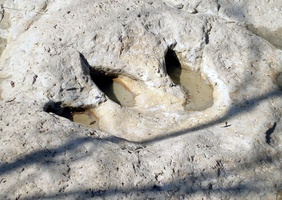
Texas State Fossil(s) - Petrified Palmwood & Paluxysaurus

Nevada State Fossil - Ichthyosaur (Shonisaurus popularis)
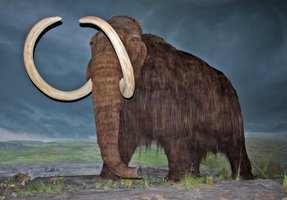
Alaska State Fossil - Woolly Mammoth
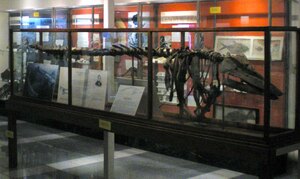
Vermont State Fossil - Mount Holly Mammoth & Charlotte Whale

Wisconsin State Fossil - Trilobite (Calymene Celebra)
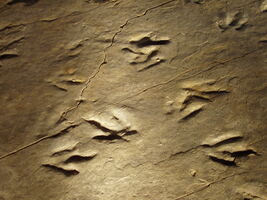
Connecticut State Fossil - Dinosaur Tracks (Eubrontes giganteus)
 Reviews
Reviews

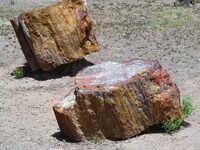

.jpg)

